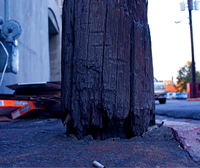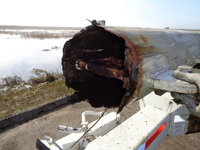A commonly agreed metric for the average service life of utility poles is approximately 40 years, although many wood poles these days are lasting less than 30 years. If poles are not lasting as long as they should, whether across an entire grid or in a very specific region, RS poles, which offer an 80-year service life and are backed by a 41-year warranty, should be used.
The following are examples of applications where specific pole materials do not meet their expected service life:
 Rot. Wood poles installed in areas with high ground water or high average rainfall can result in rot and reduced load bearing capability of the pole. The surface of RS poles is hydrophobic and will not absorb water, which means they are not susceptible to rot or deterioration.
Rot. Wood poles installed in areas with high ground water or high average rainfall can result in rot and reduced load bearing capability of the pole. The surface of RS poles is hydrophobic and will not absorb water, which means they are not susceptible to rot or deterioration.
 Corrosion. Steel or concrete poles installed in coastal areas or areas close to roadways in northern latitudes where salt crystals or brine are used for ice control during winter months have a high probability of corrosion (steel) or spalling (concrete, as a result of corroding steel rebar inside the pole). RS composite poles are impervious to salt, plus their hydrophobic surface means that the poles will maintain their self-washing characteristics over time.
Corrosion. Steel or concrete poles installed in coastal areas or areas close to roadways in northern latitudes where salt crystals or brine are used for ice control during winter months have a high probability of corrosion (steel) or spalling (concrete, as a result of corroding steel rebar inside the pole). RS composite poles are impervious to salt, plus their hydrophobic surface means that the poles will maintain their self-washing characteristics over time.
Woodpeckers. Pound for pound, nothing is more destructive to a wood pole than a woodpecker. The structural damage inflicted on wood pole lines by these 10-ounce birds is nothing short of incredible, setting the stage for catastrophic failure in high load events. Foam filler and wraps are costly band-aids that only prolong the inevitable. Solve the problem once and for all with RS poles - which also provide protection from bears, termites, carpenter ants, and other pests.